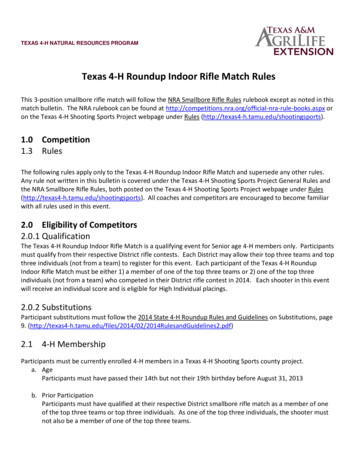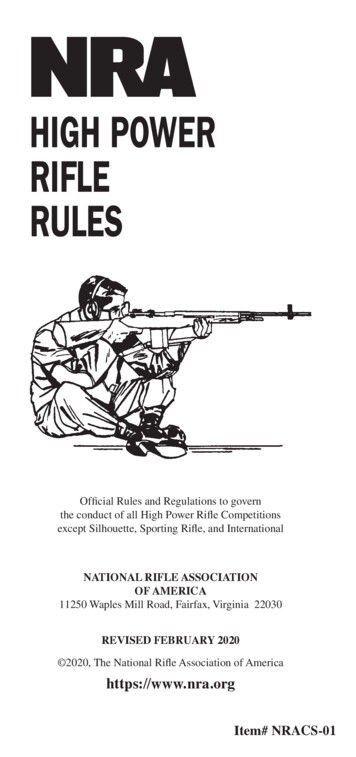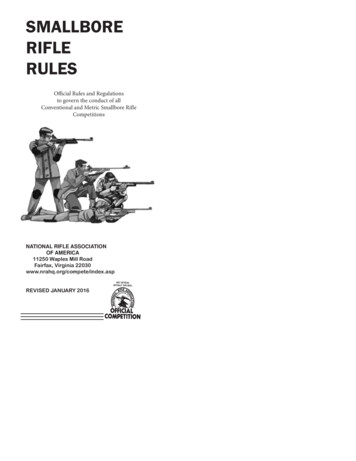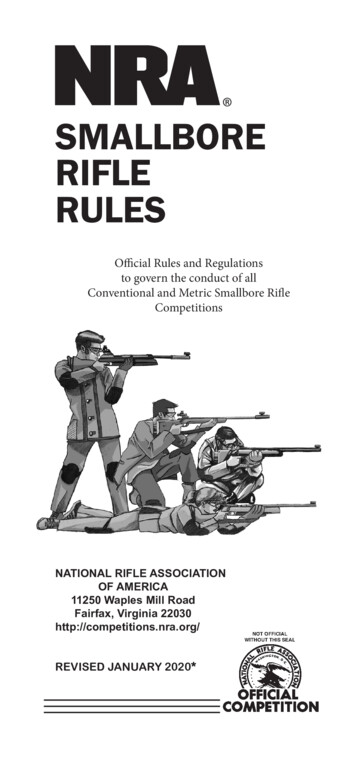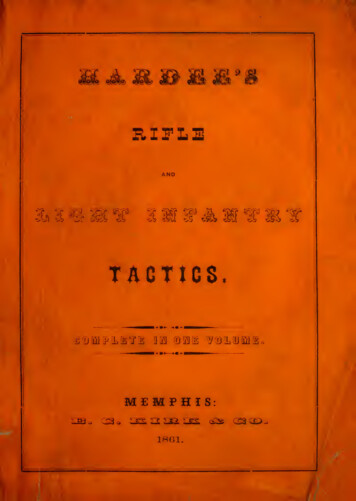
Transcription
f9HIPLEANDa.s# liBSf3 ijojl Sii i 3TACTICS,.cj EDIPiLd lOiP] K1:E WQiLOlfflllMEMPHIS:1861./
I
HARDEE'SRIFLEa(I1 rANDLIGHT INFANTRYTA.CTICS.COMPLETEmONE VOLUME.1861
Digitized by the Internet Archivein2010 with funding fromDukeUniversity leligh01hard
—:IU7lii}tx«i/3&.11 ',U til»' mvmxmw TITLE FIRST.Abticlh First.Formation qf a Regiment in order of battle,AREGIMENTen-in line.Composed of ten companlps, whichwill habitually be posted from right to left, tn the foUow1.IsIiiKorder: first, sixth, fourth, niutb, third, eighth, fiflb,tenth, seventh, second, accordiog to the rank of captains.2. With a less number of companies the same principlewill be observed, viz: the first captain will command theright company, the second captain the left company, thethird captain the right centre company, and so on."5.Th« companies thus posted will be designated fromright to Itft, ftrd company, ticcond company, &c. Thisdesignation will be observed in the manivuvres.4. The first two companies on the right, whatever theirdenomination, will form the.rtrsi division ; the next twocompanies the second division; and so on to the left.5. Each company will be divided Into two equal parts,which will bo designated as the first and secon l platoon,counting from the right and each platoon, in like manner, will be subdivided into two sections.6. In all exercises and manceuvres, every regiment, orpart of a regiment, composed of two or more companies,will be designated as a battalion.7. Th'i color, with a guard to be hereinafter designated,win be posted on the left of the right centre battalioncompany. That company, and all on Its right, will beRenominated the riijht wintj of the battalion ; the remain;ing companies the left wi7ig.8. The formation of a regiment is in two ranks; andeach company will be formed Into two ranks, in the following mannsr: the corporals will be posted in the frontrank, and on the right and left of platoons, according toheight; the tallest corporal and the talloet man will formthe first file, the next two tallest men will form the secondfile, and so on to the last file, which will bo composed ofthe shortest corporal and the shortest man.9. The Olid and even files, numbered as one, two, in thecompaay, from right to left, will form groups of four men,who will be designated comrades in halite,10. The distance from one rank to another will bothirteen inches, measured from the breasts of the rearrank men to the backs or knapsacks of the front rankmen.11. For nianncnvring, tho companies of a battalion willalways be equalized, by transferring men from theBtrODgeat to the weakest companies.Post*12.of CompanyThe companyandOjjicers,Scrgtanisofilcersand sergeants are nine inCorporals,number, and will bo posted in the following manner13. The captain on tho right of the company, touchingwith the left elbow.11.Tho first»erff«xnt In the rearrank, tonchlng withtho left olbow, and covering tho captain. In the manoeuvres he will be denominated covering sergeant, orri'i/7it guide of the company.15. The remaining ofilcers and sergeants will be postedas file closers, and two paces behind the rear rank.IG. The first lieutenant, opposite tho centre of thafourth section.17. The Second lieutenant, opposite the centre of thefirst platoon.18. Tho third lieutenant, opposite the centre of thesecond platoon.19. Tho second sergeant, opposite the second file fromthe left of the company. In tho manoeuvres he will bedesignated left guide of the company.2". The third sergeant, opposite the second file from thoright of the second platoon.21. The/o«rt7* sergeant, opposite the second file fromtho left of the first platoon.22. The fifth sergeant, opposite the second file from theright of the first platoon.23. In the left or tenth company of tho battalion, thesecond sergeant will be posted in the front rank, and onthe left of the battalion.21. The corporals will be posted in the front rank, asprescribed No. 8.25. Absent officers and sergeants will be replacedoflTicers by sergeants, and sergeants by corporals.Thecolonel mav detach a first lieutenant from one companyto command another, of which both the captain and firstlieutenant are absent; but this authority will give noright to a lieutenant to demand to be detached.Posts of Field Officersand EegimentalSlag.20.The29.The adjutant and sergeant major will bo oppositeand left of the battalion, respectively, and eightoiBcers, colonel, lieutenant colonel andmajor, are supposed to be mounted, and on active Pervicoshall be on horseback. The adjutant, when the battalion is manoeuvring, will be on loot.27 The colonel will take post thirty paces in rear cfthe file closers, and opprsite the centre of the bnttalicn,This distance will be reduced whenever there is a reduction in the front of tho battalion.28. The lieutenant colonel and the major will bo opposite the centres of the right at.d left wings respectively,and twelve paces in tho rear of the file closers.fieldtho rightpaces in the roar of thefileclosers.30. The adjutant and sergeant mnjor will aid the lieutenant colon «l and major, respectively, in thejniano uvres.31. The colonel, if absent, will be replaced by tholieutenant-colonel, and the latter by the major.If allthe field officers be absent, the senior captain will command tho battalion; but if either be present, he will notcall the senior captain to act as field officer, except incase of evident necessity.32. The quarter-master, surgeon, and other staff oill-
FOBMATION OF THE BATTALION.oen, in one rank, on tho loft of the colonel, and tbroepaces in bis rear.33. Tbo quiirtor-maater sergt-aot, on a lino wllh thefront rank of tbb field mtiBlc, and two paces on tbo right.Pottt ofFMAMutic atui Band.drawn np In four ranks, andposted twelve paces In ronr of the file closers, and loftThocentreoftboloft centre company.upposita tbo84. Th(! bnglors will bonoulor principal mti lciiin will bo two pacog in front of thefli'ld mniilc, and the other two paces iu tho rear.35. Tbo regimental band, if there bo one, will be drawnup lo two or four ranks, according to Its numbrrs, andposted live paces In rc;tr of tbo lield moaio, having ouo oftho principal musicians at its bead.Culor-ffuarJ,oftch battalion tho color-gnard will bo oompoeoilof eight corporols, and p08l d on tho left of thu rightcontro company, of which company, for the time being,tho guard will make a part.37. Tho front rank will bo composod of a sorgoant, tobe selected by tbo colonej who will bo called, for thotime, djlor-hearfr, with iho two ranking corporalH, ro-56.Inppoctivoly, on bis right auJ loft; tbo roar rank will h composed of the three corporals next in rank; nud thethree remaining corporals will bo posted in their rear,and on tho line of file cloaers. The b-ft guido of tho colorcompany, when those three last named corporals are intbo rank of hlo-closers, will bo immediately on their left.SS. In battalions with loss than five companies present,there will be no color-gnard, and no display of colors,except it may be at reviews.39. The corporals for the color-gnard will bo soloctedfrom those mDst distlnguiBhed for regularity and precision,as well In tbclr poBltions under arms us in their marching.The latter advantage, and a Just carriage of theperson, are to bo more particularly sought for la the selection of the oolor-bearer.squads, under Borgeant Instnictors, be enporintcndod, »tthe Barao time, by an officer.4C. In tho Bcho il of the company, tho lieutenant coloneland the mi or, under the colonel, will be the principaliustructora, pubstltuting frequently tho captain of thocompany, and somctluics ono of tho lieutenants; tbosuli ititute, as far as practicable, being supirintouded byono of tho principals.47. In the school of the l«tt&IIOD, tho brigadier genoral D) y constitnlu liiui elf tho principal Instructor,frequently fulntltutlng tbo colonel of tlio battalion,BomotliiuB t!io llentenunt cMonel or mnjor, und twice orthrice, In tho same courno of Instruction, each of thothreoIn this school, ali o, the Kubstitutosenior cnplulus.will always, If practicable, bo superintended by thobrigadier general or the colonel, or (in case of a captainbeing tho instructor), by tho lieutenant colonel or thomajor.48. Individual Instruction being the basis of tho iusttnctiou of companies, on which that of tho regimentdepends, and tho first principles having tho greatest Inliuonco upon this individual instruction, classts of recruitsshould be watched with tho greatest care.49. Instructors will explain, in a few clear and precisewords, tho movement to bo executed iwid not to overburden tho memory of tho men, they will ulwajs U3'J thosamo terms to explalu th.' samu iiriuriples.60. They shouM often Join example to precept, shouldkeep up tho atteutiou of the n.en by an aniHiated tone,and pass rapidly from ono movement to onolber, as soonas that which thoy command has been executed iu a satisfactory niannor.61. The eabro bayonet should only bo fixed wlun required to bo used, cither for attack or defence; tbeexorclBos and mauocuvios will be executed without the;bayonet.bl. In tho movements xshlch require the bayonet tobe fixed, tho chief of tho battnlicn will cause the signalto fixfixbayontt, to bo sonudc;.!;at this signal themenwillbayonets without comniund, and Ininn diately replacewsye beture tbo bigual.their pieces iu thopositlou theyGenialGtiicUri.40. There will be two general gnldos In each battalion,Bolbcted, for tbo time, by tho colonel, from anioDg thesergeants (other than 11 ret sergeants) tho most didtiuguished for carriage under arms, and accuracy in marching.41. These sergeants will be respectively denoiniuatcd,In the mauojnvres, right gerieral guide, and UJt j/ineralgui'le, and be posted in ;tbi line of tile cloeors ; the lirstIn rear of tbo right, aod tbo soouud iu rear of tbo leftflank of tho battalion.Abiiclb B 00KD.IrutrvcHon of Dattalior 42. Every commanding offlf-er is responslbl* for thoinstruction of his command. Lie will assomblo tbo ulllcerstogether for theoretical and practical Instruction as often08 he may Jndge necessary, and wbon unablo to attend tothis dnty in person, it will be discharged by tbo oUicernext in rank.43. Cikptains will bo held respooBlMo for tbo tl.'coreticiiland practical instrnctlon of tb''ir nou-comnilHsionod olllcers, and tbo adjutant for tho instruction of tho nou-commigsioned staff.To this end, they will require thesetactics to bo etndied and recited k«Hon by lesson ; andwhen instruction Is given on tbo ground, eiich uon-coiiimisslonod otllcer, us he explains u movement, should berequired to put it Into practical operation.44. The nou-commlsbinnod ofllcura should also bo prootisod in giving cemmandn.Bach c nimaad, iu a k-ssoti,in the theoretical instrnctl'in, should flrut bo given by theinstructor, and then repented, in aucct-ssion, by the noncommissioned offlcers, eo that while they becorim babitnatod to tho commands, nniformity may bo estublished latbo manner of giving them.4.5. In tho Hchool of tho Boldlor, the company offlcorswill bo tho instructors of the squads; but if there bo notn Bulhclent number of company ofllccrs present, Intelliil»nt Bergeanta may !« obstitnted; and two or throoIrutructlon00.Tho Instrnctlon ofo/oflBcersOJ/icen.can be i erfpctpd only byThe colonel will often pracin ostiniiiting distances, andhe will carefully endeavor to cause them to take stepsequal in K ngth and swirtiicss. Thoy will also bo exercised In tho double quick Btep.54. Tbo Instruction af cfllcers will include all theTitles In this syRtem of drill, and such regulations asproscribe their duties In peace imd wur.5.1. Every oOlcer will niHUe himself peifeetly acquainted with the bugU slgniil'': and Bbould, by pnictice, boenabled, if necewary, to sound them. Thin knowledfje,80 necessary In general InBtruction, bcocmeB o( vital iniportanoo on actual tcrvico In the tield.Joining theory to practice.tisetbemInmarching andInstructioncfSergeants.50. As the discipline and elliciency of a company nialerlally depend on the conduct and character of it-i nergeants, they should bo selected with care, ami prii .TlyiuBtructed in all the duties appertaining to their rink.67. Their theoretical luetruclion bh.iubl incluilo tlioSchool ef tho Soldier, the School of the Comjiany, ai iltbo Drill for Skirmishers. They ihould likewise knowall thu details of sorvieo, and tho rogulations preset ibingtheir duties in garrison and In campaign. 8. Tho captain selei-tH from tho corporals In his company thoBO whom ho Judges fit to be admitted to thetheorotlcal Instruction of tho sergeants.Trtttrridinnof CbrporjU.Their theoretical Instrnctlon phould Include theSchool of tho Soldier, and such ri'gulation i as prescribetheir dotics In garrison und in canipaigu.00. The captain eoleots from bin company a few privatoswho may bo admitted to the thoorotiOHl lustruction ofTO.tho corporals.
——;SCHOOL OF THE SOLDIER— PAETof ecrgeants and corporals ia intended principally to qualify them for tho inetraction ofthe privates, thoy should be taught not euly to exectite,but to explain intelligibly every thing they may bo rcqnirod to teach.Cl.As the inslrnctionCbmman !*.:I.The School of Hic Soldier will be divided into threepartB the first, comprehending what ought to be taughtto recruits without arms the second, the manual of arms,75.:;tho loadings and firings; the third, the principles of alignment, tho march by the flank, the principles of wheeling, and those of change of direction ; also, long marchesin double quick time and the run.7G. Each part will bo divided into lessons, as followsThere are three kinds.C2.The command ofcaution,whichPART rmsT.Is ailt ntinn.C3. The preparatory command, which Indicates themoyemont which is to be execated.04. The command of cMculion, such oa march or 7iaU,or, in the mannal of arms, tho part of a command whichcauses an execution.65. The tone of command should be animated, distinct,and of a loudness proportioned to tbo number of menunder instruction.06. The command attention ia pronounced at the top ofthe voice, dwelling on the last syllable.1 67. The command of ezectUion will be pronounced in atone firm and brief.08. Tho commands of caution and tho preparatory commands are herein distinguished by italics, those of execution by CAPITALS.C9. Those preparatory commands which, from theirlength, are difTicuIt to be pronounced at once, must bedivided into two or three parts, wilh au ascending prof ression in tho tone of command, but always in such amanner that the tone of execution may bo moro energeticand elevated ; the divisions are indicated by a hyphen.The parts uf commands which are placed in a parenthesisare not pronounced.Lcuson 1. Position of the soldier without arms: Eyesright, leftandfront.Lenson 2. Facings.Lesson 3. Principles of the direct step in common andquick time.Lesson 4. Principles of tho direct step in double quicktime and the run.PART 8EC0KD.Lesson 1. Principles of shouldered arms.Letson 2. Hannal of arms.Lesson 3. To load in four times, and at will.Lesson 4:. Firings, direct, oblique, by file, and by rank.Lesson 5. To fire and load, kneeling and lying.Lesson 6. Bayonet exercise.PABT TniKD.LessonUnion of eight or twelve menfor instructionin tho principles of alignment.Lesson 2. The direct march, the oblique mar h, and tbodifferent steps.Lesson 3. The march by the flank.Lesson 4. Principles of wheeling and change of direction.Lesson 5. Long marches in double quick time, and tho1.run, with arms and knapsacks.PABT- 5S FIRST.IThis will be taught, if practicable, to one recruit ata time ; but three or four may bo united, when tho number be great, compared with that of the instructers. Inthis case, the recruits will be placed in a single rank, atone pace from each ether. In this part, the recruits willbo without arms.77.TITLE SECOND.SCHOOL OF THE SOLDIER.LessonGeneral Etdet and Dieision of the School of the Soldier.70. The object of this school being the individual andprogressive Instruction of the recruits, the instructornever requires a movement to be executed until ho hasgiven an exact explanation of it ; and ho executes, himself, the movement which he commands, eo as to join example to precept, lie accustoms the recruit to take, byhimself, the poBition which is explained teaches him torectify it only when required by his want of intelligenceand sees that all movements are performed without pre-—cipitation.71. Each movement should be understood before passingto another. After tbey have been properly executed iutho Older laid down in each lesson, the juntructor nolonger confines himself to that order ; on the contrary,be should change it, that ho may Judge of the intelligence of tho men.72. The instructor allows the men to rest at the end ofeach part of the lessons, and oftenor, if ho thinks proper,especially at the commencement; for this purpose he com-mands Brst.73. At tho command Beht, thesoldier is no Ion peer required to preserve immobility, or to remain in his place.If tho instructor wishes merely to relievo tho attention oftbo recruit, ho commands, in Place— UT.ar ; the soldier isthen not required to preserve bis immobility, but healways keeps one of his feet in its place.71. When the instructor wishes to commence tho instruction, he commandsAttention; at this command,the soldier takes his position, remains motionless, andfixes his Bttentlon. I.Position of the Soldier.78. B eels on tho same line, as near each other as thoconformation of the man will permit;The feet turned out equally, and forming with eachother something less than a right angle ;Tho knees straight without 8tiCfne 8;Tho body erect on the hips, inclining a little forward;Tho shoulders equare aud failing equally;Tho arms hanging naturallyTho elbows near the body ;Tho palm of the hand turned a littlo to the front, thelittle finger behind the seam cf the pantaloons ;The head eroct and square to the Iront, without con-straint;Tho chin near tho stock, without covering it;The eyes fixed straight to tho front, and sirikiiig theground about the distance offifteen paces.liemarJcs on the position\IIethontheofsamethe Soldier.line-;79. Bccauso, if one were in tne roar of tho other, thoshoulder on that sida would be thrown back, or the position of tho aoidier would be constrained.Ueels more orleis closed;Bocan o men who are knock-kneed, or who have legswith large calves, cannot, without constrHiut, mak" tboir*heels touch while standing.,
;;::::SCHOOL OF THE SOLDIER— PART;I.anThe Instructor will take particular care that tbemovement of the head does not derange the s ]uarvness ofthe ihonlders, which will bapi cn if the movement of thenM;«atc, tf one foot wore tnrned out more than theother, a shouldfr would Ik- deranged, and If both fc«t h%too much turned out, It would not bo practlcAblo to Inrlino the upper part of the body forward without rcndoriogtho whole position nnstead;.farmer bo too sudJen.M. NVhen the Instructor shall wish tbe recruit to panfrom the atate of attention to that of eaao, ho will com-Th»f«et egnaUy turiuxl Ml, and net formkig (00larff*P4.any/« ;mandBkst.instructorDecnnec, If stiffened, constraint and fatlgne would beunavoidable.erectonwlU command1.upper part of the hodg incUning forviard;Because, commonly, recruits are disposcMl to do the reverse, to projnct the belly, and to throw back the shonlders, when they wiah to hold thcmBelves erect, fromwhich result great inconvcnionccs in marching. Thehabit of iucliuing ferward the upper ] Art of the body is80 important to contract, that the instructor must enforce it at the beginning, particularly with recrcitfl whohave naturally the opposite habit.At thoBoiup.Bteadlneas.Lesson11.F\icings.88. Facing to the right and left will be executed luono tmv, or pause. The Instructor will command1. eqitad,2.RigU(or fc/?)— Face.second command, raise tho right footon the left Iml, raiding the toi-n a little,and then" replace tho right htel by the side of the left,and on the same lino.00. Tho full face to the rear (or front) will bo executed89. At theslightly, turnIntwoUmc-3, or pauses.1.hanging naturally, clhowt near the hoily, the palmnflhf hand a little turned to thf front, the Utile finger behind the team 0/ the pantaloons ;B» ause, these positions are equally Important to theshoulder trmt, and to prevent the man from occupyingmore space in a rank than is necessary to a free use cf thepiece; they have, moreover, the advantage of keeping InIhe shoulders.i.flrstBhovMert square ;B vaii«e, If the shoulders be advanced beyond the lineof the bronst, and the back arched (the defect calledruund-fhouldtred, not uncommon among recruits), theman cannot align himself, nor use his piece with address. It 14 importaut, then, to correct this defect, andnecessary to that end th«t the coat should act easy aboutihe shoulders and arm-pits; bat In correeting this deIVct, the instructor will take caro that the shoulders benot thrown too much to the rear, which would cause thebelly to prcgect, and the small of the back to bo curved.AUention.word, the recruit will fix hli attentionat the second, he will resume the prescribed position and87.Because, It gives equilibrium to the position. The InRtructor will observe that many recruits have the badhabit of dropping a Bhoulder, of drawing In a side, or ofadvaucing a hip, particularly the right, when rnder anus.Thf«o are defects ho will labor to correct.TTiea resumption of tbe habitual position, the htp ;iheTo canse8C.Kn«e» extended wUKoiU tUffnem;The body:Squad.The Instructor2.willcommand:ABon— Face.At tho word alovt, the recruit will91. (First Time )left heel, bring the loft toe to tho front, carrythe right foot to Ihe ro»r, the hollow opposite to, and fullthree inches from, the Uft heel, the feet equare to eachother.At tho word face, the recrnit will92. {Seco id Time.)turn on both heels, raise the tee a little, extend the hams,face to tho rear, bringing, at tho same time, tho rightheel by the side of the left.03. The instiuctor will talco core that these motions donot derange the position of the body.turn on thoTh'. firmsThe farestraii/hl to the front,and wilhmitconstraintthere be stiffness In the latter position, itwould communicate itself to the whole of tho upper piirtof the body, embarrass its movements, and give pain andBecause,IfLE 60N94. Tlife length of tho direct step, or pace, lu commontime, will bf twonty-elght inches, reckoning from heel toheel, and In swiftness, at tho rate 01 ninety in a minute.'J6. Tho instructor, scoing the recruit confirmed in hisposition, will explain to him the principle and mechanlum of tills step placing himself bix or seven paces from,and facing to, tho recruit. IXo will himself executeslowly the step in the way of Ulnbtration, and then—commandfatigue.Eyes directBecause, thisshoulders in lineis1, Bq tad,to the fronttho surestmeansof maintaining the— an essential object, to belusistedenandattained.80. The Instructor having given the recruit the positionof tho soldier without arms, will now teach him the turaiug of the head and eyes. IIo will command1.j7/e«— RiGUT.2.FnONT.81. At the word right, \\\6 recruit will turn the head(iently, so as to bring the inner corner of the left ej'6 In aline with the buttons of the coat, thoeyes flxwd on thollnoof the eyes of the men In, or supposed to be In, the samerank,82.At tho second command, the headdirect or habitual position.83. Tho movement of Eyes— 'Lzn willinverse means.willresume theIII.Principhi of the Direct Step.for raud.2.Commontime.smartly, but without'j7. At the third command, he willa Jerk, carry straight forward the loft foot twenty-eighttho ground, the hamneorsoletheright,Inches from theextended, the toe a little depressed, and, as also thoat the same time,will,hoout;turnedkoeo, slightlythrove tho weight of the body forward, nod plant Hatpreciselyat tho distanceshock,withouttho l"1"t foot,where it finds itself from the right when tho weight ofwh deof which willthoforward,bronglitthe body Isnow rest on the advanced foot. The recruit will tiext,plant it asfootondriyhtthoadvanceill like manner,of thoabove, the heel twenty-eight Inches from the heelturningfoot, and thus continue to march withoutthe Bhonlders, and preserving alveayg tho face direct tothe front.leftl 8executed by3. BLinciiAt the flrst commaud, the recruit will throw thoweight of the body on tho right leg, without bonding tho06.V
::SCHOOL98.Whenbe willOffTHB SOLDIER— PARTthe Inatrocior shall wish to arrest the march,command:left foot,— will plant his1. S-ii*Cui.2.HiXT.command, whichwill be given at theinstant when either foot is coming to the grouBd, the footin the rear will be brought up, and planted by tlio Bide ofthe other, without shock.100. The instructor will Indicate, ft-om time to time, tothe recruit, the cadencoof the step by giving the commandone At the instant of raising a foot, and lico at the instantIt onght to be planted, observing the cadence of ninetysteps In a miunte.This method will contribute greatlyto impress upon the mind the two motlons to which thestep is naturally divided.101. Common time wlU be employed only In the firstand second parts of tho School of the Soldier, As soonas tho recruit has acquired steadiness, has become established in the principles of shouldered arms, and In themechanism, length and swiftness of the step in commonlime, he will be practiced only in quick time, the doublequ'ck time, and the run.102. Tho principles of the step In quick time are thesame as for common time, but Its swiftness la at the rateof one hundred and ten steps per minute.103. The instructor wishing the eqoad to march In00. A.t the secondquickttiDo, will1.minutes.115. Tho recruits will be exercised also In running.116. The principles are the same as for the double quickstep, the only difibrence consisting In a greater degree ofswiftness.117. It Is recommended In marching at double quicktime, or the run, that the men should breathe as muchas possible through the nose, keeping the mouth closed.Experience has proved that, by conforming to this prin-withmanaciple,ofmuchlonger distance, andPART SECOND.OEHEBAL BCLE8.Squad, fonoarJ.Priiidjyleacan pass over aless fatigue.command3.118. The Instructor will not pass the men to this «»condpart until they shall be well established la the position ofthe body, and In the manner of marching at the differentsteps.119. He will then unite four men, whom ho will placoin the same rank, elbow to elbow, and instruct them inposition of shoulder arms, as follows :MiBoa.Lesson IV.'II.At the third command, hewill carry forward thethe leg slightly l ent, the knee somewhat raisedleft foot, the toe first, thirty-three inchesfi"om the right, and with the feot will then execute whathas Just been prescribed for the left. This alternate movement of the lege will take place by throwing the weightof the body on the foot that is planted, and allowing anatural, oscillatory motion to the arras.114. The double quick step may be executed with different degrees of swiftness. Under urgent circumstancoHthe cadence of this step may be Increased to one hundredand eighty per minute. At this rate a distance of fourthousand yards will be passed over In about twenty-five113.th» DoubleQukbStep.The length of the douWe quick step la thirty-threeinches, and its swiftness at the rate of one hundred and101.Lessosiiify-flvo steps per minute.105. The instructor wishing to teach tho recruits theprinciples and mechanism of the double quick step, willcommand1.Dcvbh Quick Bl .2.Maech.At'the first command, the recruit will ralso hishands to a level with his hips, tie hands closed, the nailstowards the body, tho elbows to the rear.107. At the second command, he will raise to the fronthis left leg bent. In order to give to the knee the greatestelevation, the part of the leg between the knee and theinstep vertical, the toe depressed ; he will then replace hisfoot in its former position ; with the right leg he will execute what has just been prescribed for the left, and thealternate movement of the legs will be continued untilthe command :1. Siiuad.2.IlALT.108. At the second command, the recruit will bring thefoot which is raised by the side of the other, and droppingat tho same time his hands by his side, will resume the position of a soldier without arms.109. The Instructor placing himself seven or eight pacesfrom, and facing the recruit, will indicate the cadence bytlie commands, on-i and iwo, given alternately at the instant each foot should be brought to the ground, whichat first will be in common time, but its rapidity will bogradually augmented.110. The recruit being sufficiently established In theprinciples of this step, the Instructor will command:1.Squad, fmoard.3.2,DotiUeQi«efc.Mabcii.111. At the first command, the recruit will throw thoweight of his body on the right leg.112. At tho second oonunand, he will place his arms asiudiciitod Ho. 100.Arim.Therecruit being placed as explained In the firf tlesson of the first part, the instructor will cause him tobend the right arm slightly, and place the piece In it, inthe following manner121. The piece in the right hand— tho barrel nearlyvertical and resting In the hollow of the shoulder theguard to the front, the arm hanging nearly at its fulllength near the body; the thumb and fore-finger embracing tho guard, the remaining fingers closed together,and grasping the swell of the stock just under the cock,which rests on the little finger.122. Recruits are frequently seen with natural defectsIn the conformation of tho shoulders, breast and hips.These the Instructor will labor to correct in the lessonswithout arms, and afterwards, by stoady endeavors, sothat the appearance of the pieces. In the same line, maybe uniform, and this without constraint to the men intheir positions.123. The instructor will have occasion to remark thatrecruits, on first bearing arms, are liable to derange theirposition by lowering the right shoulder apd
f 9 HIPLE AND a.s#li i i BSf3l Siijoj 3 TACTICS




